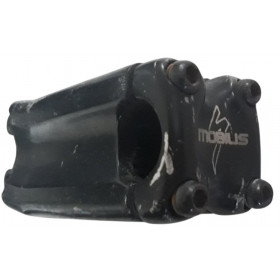-
 UsedStem 70 mm Specialized Mobius
UsedStem 70 mm Specialized Mobius- €5.99
Showing 1-1 of 1 item(s)
In the world of mountain biking, every MTB DH part plays a crucial role in enhancing your ride experience. One such essential part is the MTB DH stem, which plays a significant role in your bike's handling characteristics during high-speed descents. This guide aims to help you understand the key characteristics, recommendations, and advice for selecting the perfect downhill stem for your mountain bike.
Characteristics of MTB DH stem:
1. Length:
The length of the MTB DH stem affects the reach to the handlebars, which can impact your riding position and control over the bike. Longer stems offer a more relaxed riding position, while shorter stems provide a more aggressive stance. For downhill riding, a slightly longer stem (around 80-100mm) is often preferred to allow for better control at high speeds.
2. Rise:
The rise of the MTB DH stem determines how high your handlebars will be in relation to the steerer tube. A zero-degree stem (flat) is the most common choice, but some riders prefer a positive or negative rise to adjust their riding position. For downhill riding, a 0-10mm rise is often suitable, allowing for more control and stability during descents.3. Material:
Stems are typically made from aluminum, carbon fiber, or titanium. Aluminum stems are durable, affordable, and suitable for most riding conditions. Carbon fiber stems are lighter and offer better vibration damping but can be more expensive. Titanium stems are ultra-lightweight and strong but are less common due to their high cost.
4. Clamp diameter:
Most modern mountain bikes use a 35mm clamp diameter, while older models may use a 1-1/8" or 1-1/2" clamp diameter. Ensure that your new stem is compatible with the clamp diameter on your bike.
Recommendations and Advice for MTB DH stem:
1. Choose a reputable brand known for producing high-quality downhill stems. Brands like Race Face, Easton, and Hope are popular choices among downhill riders.
2. Consider the weight savings offered by carbon fiber or titanium stems if you're looking to shave some grams from your bike setup. However, be prepared for a higher price point.
3. Test ride various stem lengths and rises to find the perfect fit for your riding style and preferences. A proper fit can significantly improve your control and confidence during high-speed descents.
4. Be mindful of your budget when selecting a downhill stem. While it's tempting to invest in the lightest or most expensive option, there are affordable options that offer excellent performance and durability.
5. Regularly inspect your stem for any damage or wear, as a failed stem can have catastrophic consequences during a ride.
6. When installing your new MTB DH stem, ensure it is properly torqued to the manufacturer's specifications. An improperly tightened stem can loosen and compromise your handling characteristics.
7. Consider using a headset spacer or rise adapter if you need to fine-tune your handlebar height without changing stems entirely.
Conclusion :
Selecting the MTB DH stem for your mountain bike is an essential part of creating a well-rounded setup that caters to your riding style and preferences. By understanding the key characteristics, recommendations, and advice outlined in this guide, you'll be better equipped to find the perfect stem for your next downhill adventure. Happy riding!
